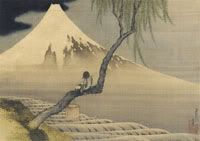
So, I've got it in my head to actually follow through with something. At least until late summer-ish. Two weeks from now, I'll be out of a real job and self-employed, so, I've decided to take a serious crack at selling my art. I've always had drawing as a creative outlet, and over the years I like to think I've honed my talent, succinctly whittled my historical interests down to a somewhat individual style. Even though I tend to jump from medium to medium, I'm hoping that each piece is a signature EV one-of-a-kind. I'm not really so vain as to think that every painting or drawing that gets splashed or scribbled onto a piece of paper is entirely my own. My mind is like a sponge, so whatever the slosh that gets wrung out, it's always going to be what some people (those who use the word "mine" a lot) may deem plagiarism. I'm sorry, but elements of Kay Nielsen, Brueghel the Elder, or some random Art Nouveau dude are going to find their way into my lines...but that's the whole of art history.
Yeah I don't understand people who are overly protective of their subject or style or whatever...man, your stuff originated from someone else. Influence is the word. And if it's not another painter, it's nature or some kind of mind-altering substance...and don't think you're the only one to have ever experienced something so bizarre...not as strange as you might think. I respect the individualism of each person and believe you should embrace what makes you unique, but not to the point where it separates you from everything else.
I have no idea where that came from, but there it is.
Anyway, I did this pic a few weeks ago, tried something new. I want to focus on childhood imagery, but not so much traditional notions of it. My childhood was fun but not necessarily overly normal. So, yeah.



















